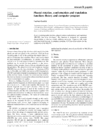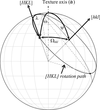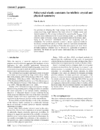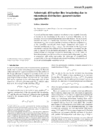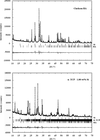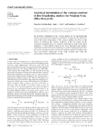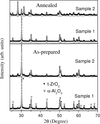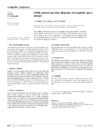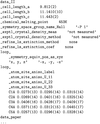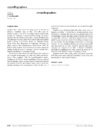issue contents
August 2006 issue

Cover illustration: Curvature mapping onto a surface drawn using the program Curvis. Courtesy of S. Piotto & R. Nesper [J. Appl. Cryst. (2005), 38, 223-227].
research papers
Combined measurements using transmission electron microscopy, small-angle neutron scattering and chemical analysis, allow the absolute determination of NbC heterogeneous precipitation on dislocations in steels.
The new phased rotation conformation and translation function (PRCTF) has been designed for automatic interpretation of electron density in X-ray crystallography, utilizing molecular fragments with conformational freedom. A computer program for the calculation of the PRCTF has been written.
A method of two-dimensional reciprocal-space mapping followed by Rietveld-type refinement of the maps has been developed and tested for stressed and strongly textured thin films with fibre texture.
The problem of obtaining the Voigt average for the elastic stiffnesses with texture-describing weight functions has been solved for triclinic crystal and physical symmetries.
A new parametrization of microstrain broadening resulting from a correlated symmetry-invariant Gaussian microstrain distribution is presented. In contrast to earlier approaches, Cartesian coordinates are used, leading to expressions that allow easy identification of isotropic microstrain broadening.
The combination of transmission electron microscopy (TEM) and in situ X-ray powder diffraction (XRPD) for the investigation of four model high-temperature shift catalysts makes it possible to obtain and compare information concerning the crystallite and particle shapes and sizes before, during and after the reduction of the synthesized hematite-based model catalyst to the active magnetite-based catalyst.
An improved algorithm for Patterson deconvolution has been tested and compared with direct-methods approaches for ab initio crystal structure solution of macromolecules.
Two methods of Rietveld refinement have been employed to estimate the crystalline phase compositions of multiphase calcium phosphate mixtures containing calcium hydroxyapatite and alpha and beta tricalcium phosphate. The methods require approximately 10 min to complete, and are suitable for quality control of calcium phosphate production (and potentially other multiphase systems) when accuracy, precision and time are all significant considerations.
A biomimetic supported liquid membrane (SLM) system was employed to control the morphology of strontium carbonate. Seeking the cooperative balance of the SLM, the modifier agent and its concentration is the key factor in this system.
Open  access
access
 access
accessThe performance of a novel large-area hybrid pixel detector designed for macromolecular crystallography is reported. Crystallographic data were collected with synchrotron radiation in conventional mode and fine ϕ-sliced mode with continuous sample rotation.
A new weighting scheme has been implemented in the EXPO2005 least-squares Fourier recycling procedure for optimizing the structure model.
The inability to determine single-step energies in some cases is highlighted and a new method is introduced that uses the bonding topology and crystal structure geometry to calculate single-step energies
In this work a combination of X-ray scattering methods for the characterization of ultra-low-energy implanted Si wafers is presented. Grazing-incidence diffuse X-ray scattering is sensitive to the properties of the residual defects confined within thin crystalline layers; X-ray diffraction provides the depth distribution of the lattice strain and specular reflectivity provides the electron density profile.
Statistics of the local morphology of grain boundaries is used to improve the quality of grain maps reconstructed from X-ray diffraction data.
Open  access
access
 access
accessSmall-angle X-ray scattering is used at two energies, one either side of the zirconium K-edge, to probe the in situ formation of an alumina–zirconia–silicate ceramic.
teaching and education
Free 

The first mobile phone application for crystallography training, Escher Mobile, is now available at http://escher.epfl.ch/mobile/.
short communications
The variance method of line-broadening analysis of polycrystalline materials has been modified to include in its mathematical core the variance coefficients calculated analytically under the hypothesis of Voigtian line profiles.
The role of oxygen vacancies in tetragonal-phase stabilization of ZrO2 has been studied by Rietveld refinement of X-ray powder diffraction data.
Crystallization of membrane proteins for three-dimensional structure determination can now be performed at the unprecedented picolitre-scale enabling the performance of thousands of crystallogenesis trials with just micrograms of protein.
computer programs
ISODISPLACE is an internet-based tool for exploring displacive structural phase transitions. It allows a user interactively to visualize and manipulate distortion modes induced by irreducible representations of the parent space-group symmetry.
The genetic algorithm is used in a full-profile fitting program to search for proper fundamental parameters that have large uncertainties.
The program SITCOM, which can be used for the comparison of macromolecular substructures from different sources for validation purposes, and for the construction of a consensus model containing sites from different substructures, is described.
Three-dimensional general position diagrams of the superfamilies of all non-cubic magnetic space groups have been developed. The diagrams can be rotated and zoomed to aid in the visualization of the general position diagrams and include both the general positions of the atoms and the general orientations of the associated magnetic moments.
CIF applications
Free 

The PyCIFRW Python package provides a conceptually simple interface to CIF files for Python programmers, with optional validation against DDL dictionaries.
laboratory notes
A simple low-cost solution for automation of conventional X-ray powder diffractometers, using a PC to collect, store and analyze the data quickly, is described.
crystallographers
Free 



 journal menu
journal menu










